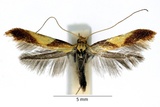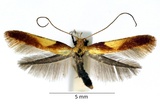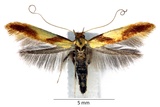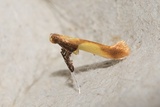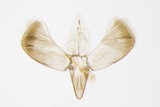Caloptilia alchimiella (Scopoli, 1763) Species
Last modified: Dec. 10, 2025, 1:32 p.m.
A common species throughout Belgium.
Details
- Classification
- Family: Gracillariidae > Subfamily: Gracillariinae > Tribus: Gracillariini > Genus: Caloptilia > Species: Caloptilia alchimiella
- Vernacular names
- Goudvleksteltmot (NL), Yellow-triangle slender (EN), Eichen Blatttütenmotte (DE)
- Synonyms
- Caloptilia franckella (Hübner, 1813) and Caloptilia hilaripennella (Treitschke, 1833)
- First mention in Belgium
- De Sélys-Longchamps E. 1844. Énumération des insectes Lépidoptères de la Belgique. — Mémoires de la Société royale des Sciences de Liége 2: 1–35. On page 25 (as hilaripennella). view page
- Status
-
Native
Distribution
Imago
Rather easily recognisable by the yellowish triangular spot on the forewing costa of which the outer margin is prolonged towards the apex of the wing. In the similar species Caloptilia robustella, this spot is not prolonged towards the apex.
Other differences: crest on C. alchimiella purple-brown, darker than the thorax; in C. robustella yellowish as the thorax.
Thorax in C. alchimiella gold-yellow with pale purple-brown tegulae; in C. robustella yellowish with same-coloured tegulae.
Forewings of C. alchimiella with sharply defined basal spot; limited in C. robustella diffuse.
External border of the costal spot in C. alchimiella almost ending in the apex; at C. robustella at about five-eighths striking steeply on the costa.
Small and indistinct yellow spot on the tornus (inner angle) present in C. alchimiella, absent in C. robustella.
Mine
Underside gallery mine on Quercus leaves.
See also gracillariidae.net and bladmineerders.be.
Bionomics
Eggs are laid on the underside of a leaf. The caterpillar, when young, forms a gallery mine at the underside of a leaf, later it lives in 2 or 3 successive cones, rolled down at the top of a lobe. Pupation under a greenish membrane on the underside of a leaf. The pupa hibernates.
The adults rest on tree trunks during daytime and later come to light.
Flight periods
The adults fly from late April till mid-August.
Observed on
- Host plant (species):
- Quercus robur, Quercus petraea and Fagus sylvatica
- Host plant (genera):
- Quercus
The caterpillars feed on different species of Quercus, but mainly on Quercus robur. Occasionally also found on Fagus sylvatica.
Habitat
In most of the localities where Quercus trees grow.
